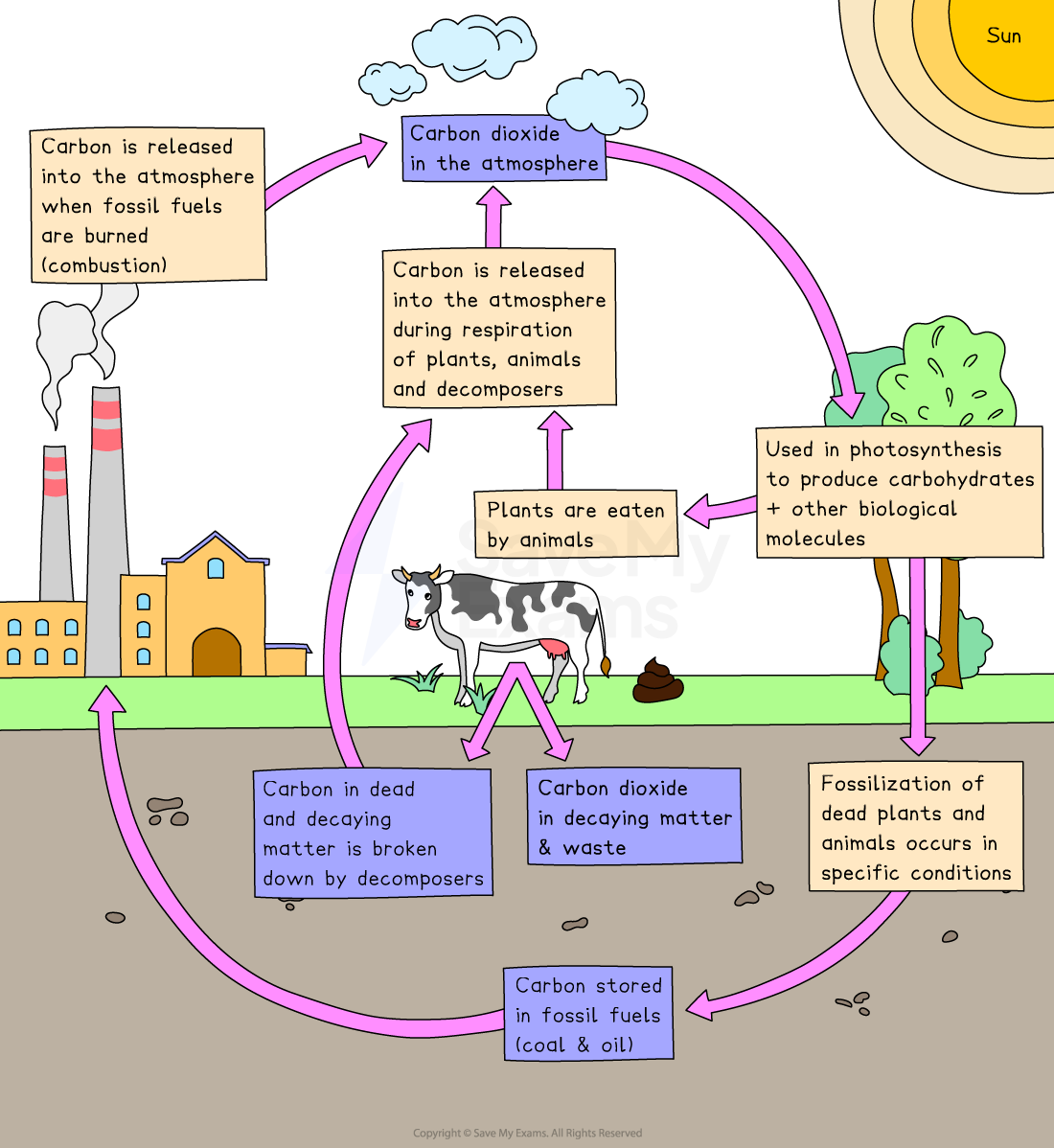The Carbon Cycle (College Board AP® Environmental Science): Study Guide
What is the carbon cycle?
Many different materials cycle through the abiotic and biotic components of ecosystems
All materials in the living world are recycled to provide the building blocks for future organisms
Elements such as carbon are not limitless resources
There is a finite amount of each element on the planet
Elements need to be recycled in order to allow new organisms to be made and grow
Carbon is constantly being recycled around the biosphere so that the total amount of carbon in the biosphere is essentially constant
Carbon is transferred from one form to another by the various processes in the carbon cycle
The carbon cycle is the set of processes by which carbon atoms and carbon-containing molecules move between Earth’s atmosphere, oceans, land, and living organisms
Carbon moves through sources (which release carbon) and sinks (which absorb carbon)
This cycle is vital for maintaining the balance of carbon, regulating global temperatures, and supporting life
Carbon sources
Carbon sources release carbon
Examples include:
Burning fossil fuels
Respiration by plants and animals
Volcanic eruptions
Decay of organic material
Carbon sinks
Carbon sinks absorb or remove carbon from another part of the carbon cycle
Examples include:
Forests (terrestrial biomass)
Oceans (dissolved CO₂, phytoplankton)
Soil (organic matter and carbonates)

Fast and slow stages of the carbon cycle
The carbon cycle consists of fast and slow stages that regulate the movement of carbon through the Earth’s systems:
Fast stages of the carbon cycle
Photosynthesis:
Plants absorb carbon dioxide (CO₂) from the atmosphere to produce glucose
Respiration:
Animals and plants release CO₂ back into the atmosphere through metabolic processes
Decomposition:
Microorganisms break down dead organisms, releasing CO₂ or methane (CH₄) into the atmosphere
Combustion:
Burning of organic matter (e.g., fossil fuels or biomass) releases stored carbon as CO₂
Slow stages of the carbon cycle
Weathering and erosion:
Carbon dioxide reacts with water to form carbonic acid, which dissolves rocks, releasing bicarbonates into the ocean
Sedimentation:
Bicarbonates are used by marine organisms to form shells, which accumulate as sediment and eventually become limestone
Subduction and volcanic activity:
Tectonic movements subduct carbon-rich rocks into the mantle, where it is released back into the atmosphere through volcanic eruptions
Carbon reservoirs
Carbon reservoirs are storage locations for carbon in different forms, including:
Carbon dioxide (CO₂)
Methane (CH₄)
Organic material
Types of carbon reservoirs
Long-term reservoirs
Store carbon for millions of years
Examples include:
Fossil fuels: Coal, oil, and natural gas buried underground
Carbonate rocks: Limestone formed from marine organisms' skeletons
Long-term reservoirs are critical in maintaining stability over geological time
Short-term reservoirs
Hold carbon for shorter timescales (days to decades)
Examples include:
Atmosphere: Stores CO₂ and CH₄
Living organisms: Plants and animals store carbon in organic forms
Soil: Stores carbon from decaying plant and animal material.
These reservoirs are highly dynamic and quickly influenced by processes like photosynthesis and respiration
Ocean carbon storage
Surface ocean (short-term reservoir):
The upper layer of the ocean, where CO₂ exchanges with the atmosphere, is considered a short-term reservoir
Carbon cycles here on the scale of days to years
Deep ocean (longer-term storage):
Carbon that sinks into deeper layers (via biological and physical processes like the biological pump) is stored for hundreds to thousands of years
This can classify parts of the ocean as a medium- to long-term reservoir
For example, carbon in deep-sea sediments or dissolved inorganic carbon is effectively removed from the atmosphere for extended periods

Carbon cycling between photosynthesis & respiration
Photosynthesis
Plants, algae, and some bacteria absorb CO₂ from the atmosphere or water
They use sunlight to convert CO₂ and water into glucose and oxygen
Examples:
Terrestrial ecosystems: Forests like the Amazon rainforest absorb vast amounts of CO₂
Marine ecosystems: Phytoplankton in oceans play a critical role in removing CO₂ from the atmosphere
Respiration
All living organisms release CO₂ back into the atmosphere or water through cellular respiration
This process converts glucose and oxygen into energy
CO₂ is produced as a byproduct
Example:
Animals, fungi, and decomposing microbes all contribute to respiration
Photosynthesis and respiration form a short-term carbon cycle, creating a continuous exchange of carbon between living organisms and the environment
Atmospheric carbon reservoir
Carbon is stored in the atmosphere primarily as CO₂ and CH₄ (methane)
Natural carbon fluxes
Carbon enters the atmosphere from natural sources such as respiration, volcanic eruptions, and the decay of organic matter
Carbon leaves the atmosphere when absorbed by plants, oceans, or soil.
Decomposition and carbon storage
Plant and animal decomposition transfers carbon to the soil
Over millions of years, some carbon becomes fossil fuels
Human impacts
The burning of fossil fuels is an unnatural (antrhopogenic) source of carbon entering the atmosphere
This activity rapidly releases large amounts of carbon, previously stored in long-term reservoirs, into the atmosphere as CO₂

Unlock more, it's free!
Did this page help you?